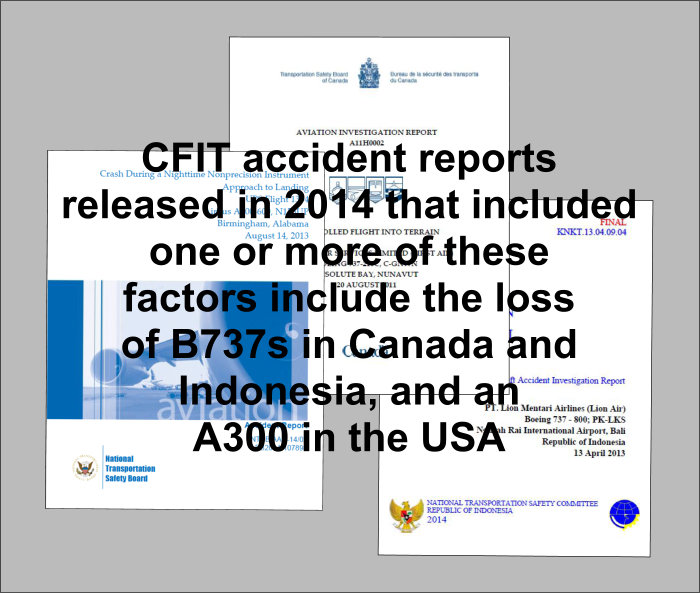Airline accidents are extremely rare, but they still occur too frequently.
Pilots are the last line of defence against errors and failures elsewhere in the aviation system, and continually demonstrate that they are extremely effective in that role. Paradoxically, it is partly because of that effectiveness that errors by flight crews themselves remain the largest single contributor to the current accident rate.
"Controlled flight into terrain" still plays the predominant role in "crew-caused" accidents.
Achieving the airline industry's target safety level requires a global reduction in collective crew errors of the order of 80%, but three decades and more of attempts to achieve this by training aimed at improving the performance of individual crew members shows little prospect of meeting that objective.
Poor monitoring and "Loss of control" is now a major problem.
In addition to CFIT accidents, "Loss of Control" (LOC) accidents have become of increasing concern in recent years.
The Flight Safety Foundation noted in February 2013 that
"CFIT, approach and landing, and upset aircraft accidents continue to account for the majority of accidents and cause the majority of fatalities in commercial aviation. There were only seven commercial jet accidents in 2012, but six of the seven (86 percent) were approach and landing accidents, and three of the seven (43 percent) were CFIT.
The upward trend of CFIT accidents for all commercial jets since 2009 is disturbing, particularly because more than 95 percent of commercial jets have been equipped with terrain awareness and warning systems (TAWS) since 2007. During the past six years, there have been 37 commercial aircraft CFIT accidents (14 jet, 23 turboprop).
In the past two years, more than 50 percent of the commercial jet fatalities have been caused by CFIT accidents."
An exemplary developed country.
A common impression in the aviation industry is that in the 21st century, air safety is only a significant problem in developing countries. Better regulations, training, automation and equipment like GPWS have made problems go away in the "developed" world.
For example, we could take Canada as an example of a well developed country, with high standards of training and regulation and a huge amount of expertise in its aviation industry. But CFIT accidents are still on the list of transportation safety issues that pose the greatest risk to Canadian citizens.
Canada is cited here not to criticise, but for exactly the the opposite reason: because it is a country with a very good overall safety record, that produces high quality safety information where most of rest of the world does not. That exemplary safety information however shows that between 2000 and 2009, Canada alone saw 129 CFIT accidents.
The number of such accidents every year has not gone down: in 2010, there were 13; in 2011, there were 14. These accidents involved many multi-crew (2 pilot) aircraft as well as small single pilot types. CFIT accidents, unstable approaches and landing over-run accidents, all symptomatic of approaches which have been poorly managed by fully trained and qualified pilots, remain the featured risks in Transport Canada's November 2014 "watchlist".
Since this is what we find in one of the world's most sophisticated, well organised and relatively low-risk countries, the sitiuation in many, if not most, other regions is inevitably considerably worse, as is shown in ICAO's 2013 report.
"Pilot error" accidents in descent, approach and landing almost always involve at least one of three main factors:
- inadequate initial preparation for, and management of changes during, the approach;
- failure of the other crew member(s) to intervene effectively while monitoring the pilot flying's actions and decisions
- loss of control of the flight path during transition from instrument to visual references.

The role of "SOPs".
A primary safety tool for flight crews is their Standard Operating Procedures (SOPs). The most basic crew coordination procedure in common use throughout the aviation industry contains a number of fundamental "design flaws", widely recognised by many who have studied accident histories.
This basic duty allocation does not adequately protect against factors that cause the majority of accidents and serious incidents occuring in the most hazardous phase of flight, the approach and landing. This core SOP simply does not accommodate a number of well established human physiological and psychological limitations.
These limitations are not a major problem in typical, "normal" conditions. But they become highly significant on a small minority of occasions, when they may result in a disaster. They affect how crew members reach decisions about the initial conduct of the approach, how critical decisions are made when transitioning from instrument to visual references for landing, and how errors made by crew members themselves are detected and corrected before they can become catastrophic.
"Monitored approach" procedures (PicMA) were specifically developed decades ago to address these very issues. Canada's Transport Safety Board has noted that Canadian operators that use "monitored approach" procedures have experienced very few accidents in low visibility, despite a high exposure to such conditions. In 2006, it published advisory information on the benefits of the procedure and allows operators credit in reduced RVR minima if they use it.
Adopting PicMA as a basic procedure is a simple change in crew duties that would have an enormous impact on overcoming these human limitations, at virtually no cost. But although successfully implemented by many airlines, it is still the subject of great resistance in the majority of the flight operations community, which is extremely reluctant to change long-standing behaviour patterns. Aspects of this resistance are discussed in the pages on airline culture and acceptance.
The purpose of this website is to convince those with influence to address this situation, and minimise future "crew-caused" accidents.